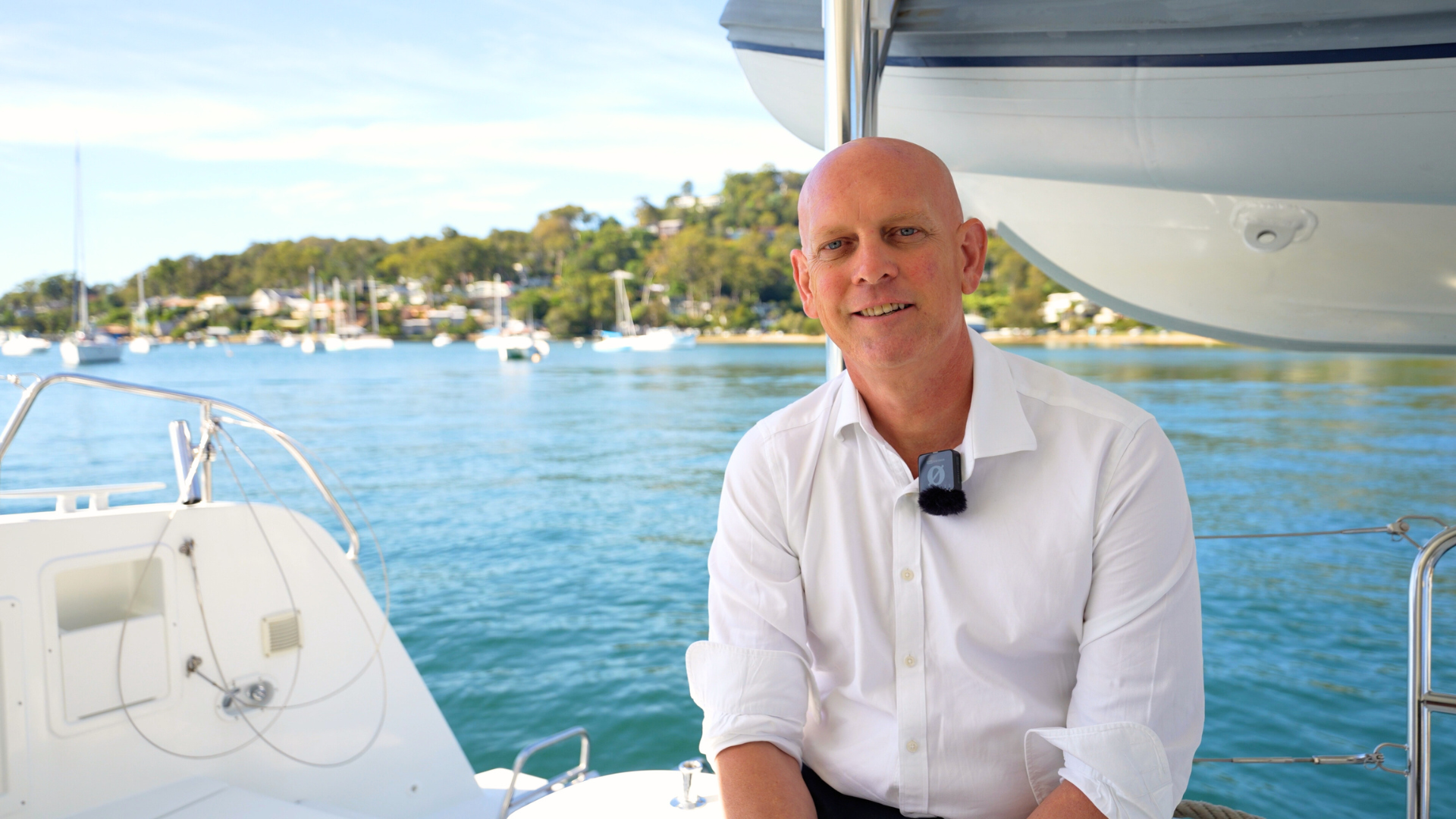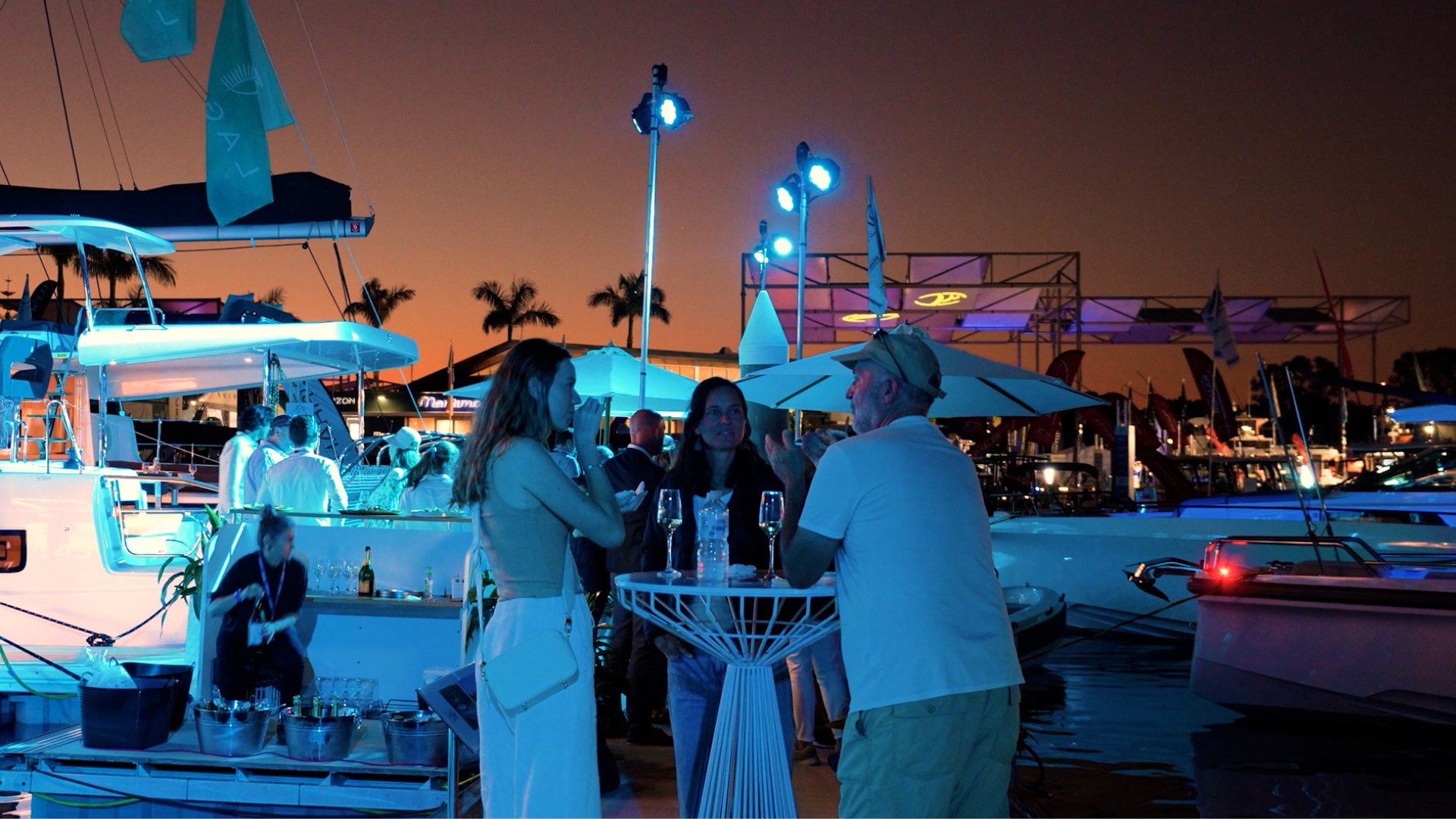SURVIVING CYCLONE DEBBIE
Michael and Ann Kornfeld and their sea dog Zara have an enviable life. Using their Lagoon 52 as their home and office, they spend most of the year cruising up and down the eastern seaboard, with the delightful Whitsundays serving as base, popping back to shore every few weeks to provision up and attend to their medical practices.
Michael’s ‘workaholic’ days are fortunately behind him, and he now relishes taking time to ‘smell the salt air.
“The forces of nature are far greater than the forces of man”
In March, The Kornfelds were out at sea around the Whitsundays as news of Cyclone Debbie’s approach started to cause concern- she was going to be a big one, a Level 4 or possibly even 5, a slow moving and severe storm system.
The weather was already deteriorating when they had to make a call: would they head back to the mainland and possible safe harbour; head north or south in uncomfortable conditions and attempt to steer clear of the cyclone’s path; or head into Hamilton Island and weather the storm?
The Kornfeld’s Lagoon 52 is very capable of oceanic travel, she can handle large seas and unfavourable conditions, but they chose to take the relative shelter of Hamilton Island. The marina is on the lee side and it tends to be quiet at this time of year, compared with the hustle and bustle of the summer season. They made their preparations with little time to spare.
Preparation is everything
Michael had a few things in his favour once in the marina. He is a very experienced sailor with two cyclones under his nautical belt. And he has tried and tested methods, “little subtle things”, gained over the years, for protecting his boat, which paid off.
Here’s how…
Critical advice to prepare your boat
The choice of berth. Select a newer finger with good structural integrity, in an area of the marina where the severity of winds will be less due to topographical cover, such as close to or behind a hill.
The way you tie up the boat. Too tight, and severe weather will cause the boat and the finger to fight against each other, causing tremendous forces on the mooring lines and cleats. Too loose and the shock loads that are caused when the boat is arrested against the finger will cause the boat to break up. Avoid either extreme: you have to think carefully about the direction of the greatest source of force from the wind and act accordingly:
*very heavily and overly fender the side that’s going to take the most battering;
*lines need to be tied diagonally (not perpendicular) between the boat and the finger;
*lines need to be reasonably short on the side where the fenders are baring the brunt, lessening the movement away from fenders, and avoiding the shock; and
*on the opposite side of the boat, tie the lines looser, so the boat can almost squeeze the fenders to stop the shock from the other side as those lines take up taught.
Consider the distribution of forces and loads on the mooring lines and cleats of the boat and the finger.
People often double up ropes in a way that doesn’t distribute loads evenly. Michael suggests you give much thought to spreading loads equally, to every cleat of the boat at extremes of the forces on those cleats, as well as the distribution of forces on each cleat on the finger. Consider this on both sides of the boat.
Readjust. Once the lines have been attached and start working under force, there will be differing amounts of stretching. If possible, allow some time to review the movement and forces and re-adjust again. Michael did this himself, conducting a finer adjustment before taking shelter on the island.
Other considerations
Tie down or remove soft objects
It is crucial to look after things that are soft or can fly around. Sails and screens must be tied down, stored inside, or lashed down as appropriate.
Whereas there is a school of thought that screens should be shut, zipped and left in place, the Kornfelds did this and lost their screens and the canvas in the storm. This leads them to advise that all soft items should be removed in severe weather, leaving bare stainless steel frames, which should withstand the storm.

Michael took down the large screecher and laid it down around the lee side of the boat against the rails, lashed it very well and secured the lines.
The furling self tacking jib was unfurled and then re-furled very tightly, but if you have time, it should be taken off the furler, folded and stored. The careful way Michael furled the jib left it undamaged.
The mainsail was taken down and secured in the sail bag and lashed all around with additional lines to the boom. In this case, the bag was damaged but not the sail.
Also to consider were the davits and the canoe at the rear of the boat. The front of the boat was angled to take the brunt of the storm, but often dinghies and canoes are filled with water and secured with ties. Instead, Michael left his canoe on the davit, secured well with pull to the rear, using elastic cables to keep the canoe away from the boat, and this flexibility resulted in keeping the canoe safe.
Don’t forget Power and Water may be lost
During a cyclone it is likely that power and water to the finger will be lost, which can be prolonged beyond the cyclone. Michael recommends preparing the electrical systems on the boat by reducing power consumption- empty and shut down the fridge, ensure loads on power are minimal, charge batteries, and fill tanks with fresh water.
The storm
Evacuation is compulsory on Hamilton Island, so waiting until the last moment, once strong winds and rain were fully upon them, using every last moment to prepare their boat, the Kornfelds joined 140 other people evacuated to the convention centre. They were looked after very well, despite a few hairy moments when the structure of the convention centre itself was challenged!

Over those two nights while they weathered the storm, Michael worried about the possibility of a storm surge that would result in the pontoon floating off its pylons and the boats piling up. This happened with Cyclone Yasi at Cardwell marina. But luck was on their side, and the fear of losing not just their boat, but their family home and office, was thankfully unfounded.
When the Kornfelds returned to their boat there was no power or water as expected, but they started up their generator and counted themselves lucky that they only lost their screens and canvas, remaining otherwise unscathed.
The Lagoon 52 toughs out the storm

The Lagoon 52 is a heavy catamaran, tough and well built, and Michael sees this as a very important point in coming through severe weather both at sea and moored. It’s a solid boat with excellent structural integrity and exceptional strength and quality of fittings; according to Michael, the 52 “shines in those areas”. A testament to its robustness, the Kornfeld’s catamaran was only the second boat to leave the marina after the cyclone, to free up a berth for more damaged boats.
Lessons learnt
With more time, Michael would have taken the canvas and screens down and stowed them securely, leaving just the bare stainless steel frames, which are capable of surviving a severe storm.
Michael says that “No one will look after your boat better than you” in a challenging situation and your intimate knowledge of your boat will help you to prepare.

“The more time and thought and focus you put in to preparation, as much as the situation allows, the better the outcome”.
If you can avoid being in the path of a cyclone, do so, but above all Michael says “there is no substitute for good luck!”.
What’s next for Michael and Ann?
Right after Cyclone Debbie passed through, and a night of intense electrical thunderstorms spent in the marina, Michael and Ann took some time to clean and prepare their boat and left Hamilton Island. Their Lagoon 52 had proved its hardiness- there wasn’t a single drop of water inside the boat, a claim not many structures could boast after such an experience.
They are happy to be out at sea again. They have surveyed the area in the last week, on the southern side of Hook Island, exploring the inlets and back to Cid Harbour. Usually a magnificent and historical place, the landscape had suffered noticeably in the storm.
The Kornfelds have seen multiple wrecks and debris, reminding them again of their luck and good decision making. Michael also had praise for the island residents who showed such resilience in the face of nature’s harshest side, with a swift clean up undertaken as soon as was practical.
Michael and Ann will stick around in the Whitsundays for a bit; a lot of marinas on the mainland are not yet ready to take boats after the damage they sustained. After Easter they will begin a 3 month stint at their practices in Mackay, Rockhampton and Gladstone, where they will continue to reside on their trusty Lagoon 52. After that, perhaps a cruise to Tassie, or Magnetic Island – the options are endless.
The couple are grateful to have been relatively unscathed in Cyclone Debbie’s path. They know they were fortunate, and their hearts go out to others who didn’t fare as well.
Michael’s final piece of advice is this: “…prepare well, and be prepared, go forth and adventure, and live life”.
LATEST FROM THE BLOG
John Cowpe – TMG Yachts Co-Founder
From sailing the wild coastlines of Scotland to steering one of Australasia’s leading yacht dealerships, John Cowpe’s journey is driven by passion, vision, and a deep connection to the sea. As Managing Director of TMG Yachts, he shares what boating means to him — freedom, exploration, and community — and how TMG is making it easier for more people to embrace life on the water.
Schengen Visa Guide for Australians in the Mediterranean
How can I stay longer in Europe? This Schengen Visa Guide teaches you the Schengen zone rules and how to extend your Mediterranean cruise.
Premier Launch of the Lagoon 43 at Sanctuary Cove Boat Show
The Lagoon 43 has officially arrived in Australia! Join us as we recap an unforgettable evening at the Sanctuary Cove International Boat Show, where Lagoon owners, clients, and cruising dreamers gathered to celebrate the Southern Hemisphere launch of this stunning new model.



